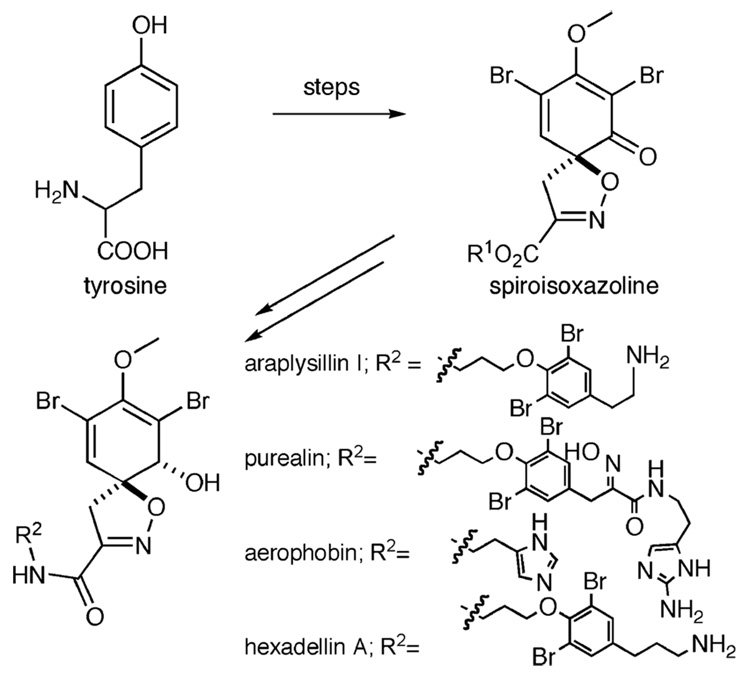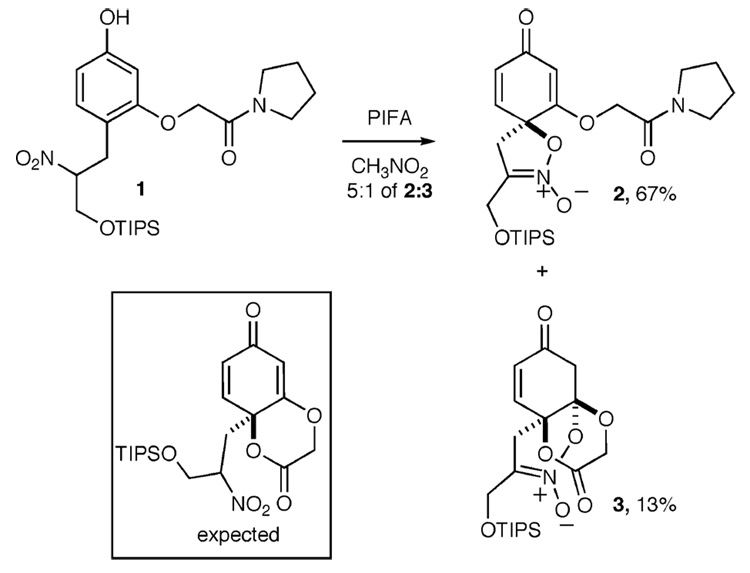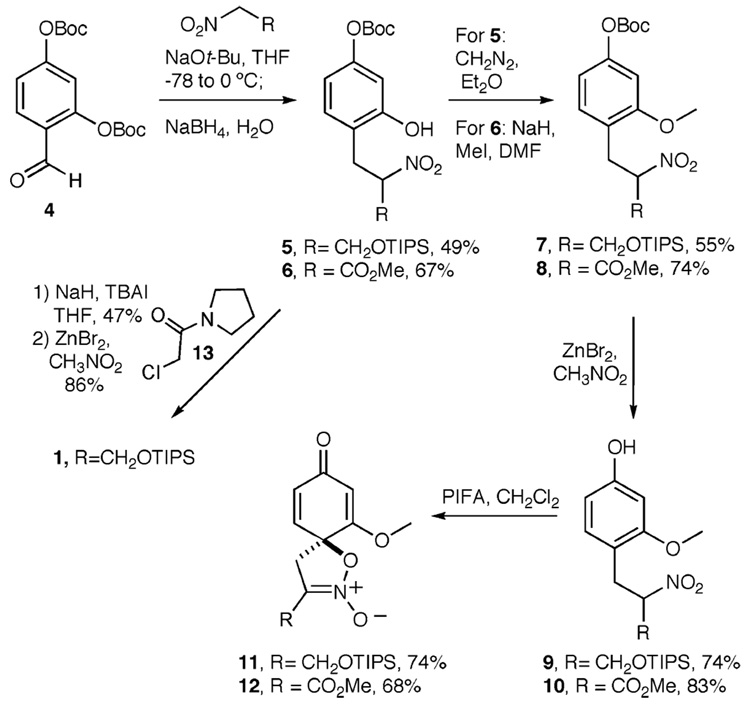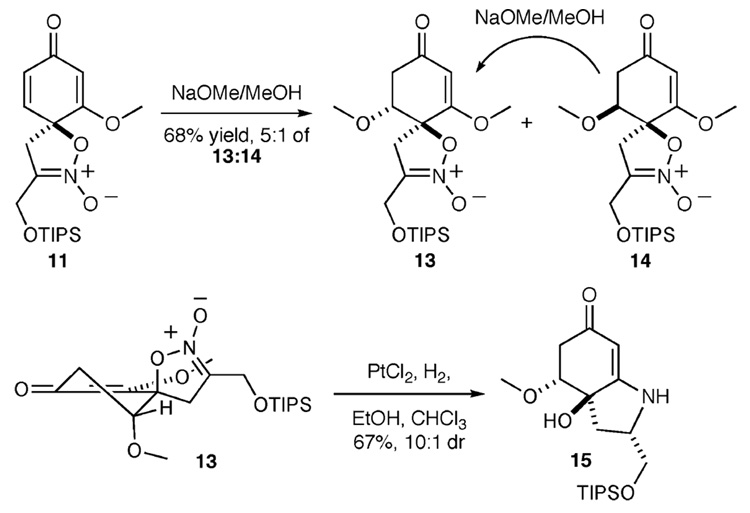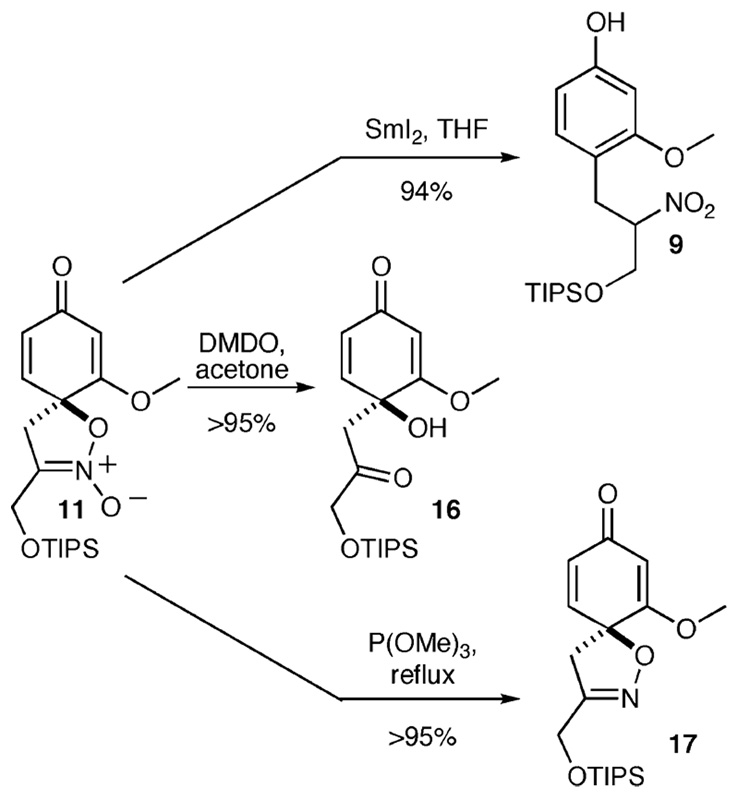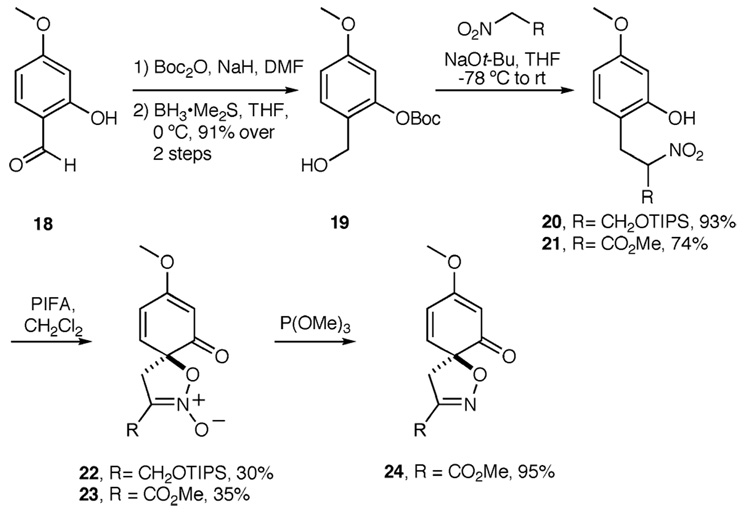Abstract
Syntheses of several unique spironitronates are reported. The key transformation involves the first known example of an ipso oxidative cyclization of nitro functionality. Oxidation proceeds from both o-and p-phenols. Reductions of these compounds provide novel spiroisoxazoline derivatives.
Natural products isolated from marine sponges come in a variety of exotic forms. Secondary metabolites derived from the oxidation of tyrosine, in particular, halogenated derivatives, have a wide range of biological activity.1,2 The biosynthesis of these compounds purportedly involves bromination of tyrosine followed by oxidation of the amine to an oxime and concludes by oxidative dearomatization to form the spiroisoxazoline core.3 The latter scaffold is then further processed by reduction and conversion of the ester moiety into an amide (Figure 1). A number of syntheses of spiroisoxazoline natural products have been reported; most appear to resemble the reported biosynthesis.4
Figure 1.
Biosynthesis of spiroisoxazoline derivatives.
Hypervalent iodide reagents (diacetoxyiodo)benzene (PIDA) and bis(trifluoroacetoxyiodo)benzene (PIFA) as well as other chemical oxidants such as thallium(III) nitrate, manganese-(III) acetate, and even electrochemical oxidations have all been shown to mimic the postulated biosynthesis.4a–n The reaction proceeds by formation of a phenoxonium and concomitant 5-exo-trig intramolecular nucleophilic attack of the oxygen atom of the oxime to afford a spiroisoxazoline. It occurs with a variety of substituents on the aromatic ring, including halogen and methoxy substituents. Our interest was sparked during studies with resorcinol derivatives (Scheme 1).5 When phenol 1 (0.05 M in CH3NO2) is subjected to PIFA, the expected lactone (Scheme 1, inset) is not observed. Instead, the spironitronate 2, arising from nitro attack and subsequent loss of a proton, is produced in 67% yield. In addition, 13% of tricyclic lactone 3 is obtained displaying four AB coupling patterns in the 1H NMR spectrum.
Scheme 1.
Unanticipated Spironitronate Formation
We speculate compound 3 arises from cyclization of the amide carbonyl and after hydrolysis of the iminium intermediate as expected (cf. Scheme 1, inset) undergoes an intramolecular 1,4-addition to the vinylogous ester by an oxygen atom belonging to the nitro group.6 The facile addition of the electron-deficient nitro group to the phenoxonium as compared with the corresponding addition of the supposedly more nucleophilic amide carbonyl was indeed surprising. Subsequent studies have shown that placement of a substituent between the oxygen atoms of the resorcinol greatly facilitates cyclization of the oxygen atom of the amide carbonyl.7 However, to the best of our knowledge, this is the first example of an oxidative dearomatization affording a spironitronate and as such deserved some additional investigation.
We decided to probe the scope and generality of this transformation as compared with the complementary oxime oxidative cyclization. We began from the known bis-OBoc benzaldehyde, 4, which undergoes addition of the sodium salt of TIPS-protected nitroethanol (0.3 M in THF).8 The intermediate product is reduced in situ with NaBH4. This one-pot transformation proceeds by 1,4-reduction of an o-quinone methide (o-QM) intermediate generated by an anionic cascade to provide the phenol 5 in 49% yield (Scheme 2).9 After failing to methylate the resulting phenol under a variety of conditions (AgOTf/MeI; DEAD/MeOH), the necessary methylation of phenol 5 (1.4 M in Et2O) was eventually accomplished with diazomethane to afford the methyl ether 7 in an acceptable 55% yield. Deprotection of the BOC residue in 7 (0.05 M in CH3NO2) with ZnBr2 affords the phenol 9 in 74% yield. This three-step sequence was also carried out using methyl nitroacetate in place of TIPS-protected nitroethanol and thereby provides the phenol 10 under similar conditions. A similar strategy of attachment led to phenol 1, which prompted this initial study. Oxidative dearomatization of 9 (0.05 M in CH3NO2) with PIFA provides the p-quinol spironitronate 11 in 74% yield. Similarly, oxidation of phenol 10 provides spironitronate 12 in 68% yield. The timing as to the loss of the nitro α-proton remains unclear. With these results in hand, we set out to probe the reactivity of these novel compounds with respect to reduction and other functional group manipulations.
Scheme 2.
General Synthesis of p-Quinol Spironitronates
Attempts to reduce the spironitronate 11 were unsuccessful. Exposure of 11 to metal catalysts and an H2 atmosphere resulted in decomposition, presumably by single electron transfer and rearomatization as is the case with cyclohexadienone p-quinols.10 To circumvent this problem, 1,4-addition of methanol to the enone moiety of 11 was examined (Scheme 3). Treatment of 11 with catalytic sodium methoxide (0.1 M in MeOH) at 0 °C affords a 5:1 mixture of spironitronates 13 and 14 in a combined 68% yield. The major diastereomer 13 reflects addition to the more congested face of the enone 11. Monte Carlo conformational analysis with Macromodel using MM3 parameters predicts a 0.5 kcal/mol energy difference between diastereomers 13 and 14, favoring the former isomer.11 Furthermore, after purification, resubmission of the minor diastereomer 14, which arose from addition to the least congested face of the cyclohexadienone of the spironitronate 11, to the earlier conditions provides the same 5:1 ratio of 13:14. With the cyclohexadienone partially reduced, reduction of the spironitronate moiety was reexamined. Hydrogenation of 13 (0.1 M in EtOH, 1 equiv CHCl3) with platinum(II) oxide12 under an H2 atmosphere affords the vinylogous amide 15 in 67% yield with 10:1 dr. While the relative stereochemistry of the major diastereomer could not be determined by NOE with absolute certainty, it is likely that reduction occurs from the less congested Re face of the spironitronate 13 as the Si face is blocked by the vinyl methoxy residue. This result illustrates the steric and electronic difference between the two faces of the nitronate moiety and might suggest application of the reverse strategy: use of a chiral α-carbon substituent to direct oxidative dearomatization in a diastereoselective manner.
Scheme 3.
Stereoselective 1,4-Addition and Reduction of 11
Reductive rearomatization of 11 proceeds via single-electron transfer with samarium diiodide (0.1 M in THF) and affords the phenol 9 in 94% yield (Scheme 4). The addition of dimethyldioxirane (DMDO, 0.08 M in acetone) to 11 cleanly affords the p-quinol 16 in > 95% yield. Further epoxidation of 16 (0.5 M in CH2Cl2) with m-CPBA at 0 °C affords a single diastereomer of an epoxide of the vinylogous ester. However, the decomposition of this product thwarted rigorous identification. On the other hand, reduction of the nitronate moiety of 11 with refluxing trimethylphosphite (0.13 M) affords spiroisoxazoline 17 in quantitative yield.
Scheme 4.
Other Transformations of 11
Next, we set out to synthesize the corresponding o-quinol spironitronates, which in principle enables access to spiroisoxazoline natural products. Boc-protection and subsequent reduction of commercially available 2-hydroxy-4-methoxy-benzaldehyde 18 affords the known benzyl alcohol 19 in 91% yield over two steps (Scheme 5).13 Sodium tert-butoxide was added to generate an o-QM intermediate, which is then trapped by the anion of TIPS-protected nitroethanol to provide phenol 20 in 93% yield. Similarly, the addition of methyl nitroacetate to the generated o-QM affords phenol 21 in 74% yield. Oxidative dearomatization of 20 (0.05 M in CH2Cl2) with PIFA provides the TIPS-protected o-quinol spironitronate 22 in 30% yield. Likewise, oxidation of 21 provides o-quinol spironitronate 23 in 35% yield. Reduction of 23 with trimethylphosphite affords the desired spiroisoxazoline 20 in 95% yield. The lower yields for oxidation as compared with the corresponding p-quinol derivatives were disappointing. We speculate that the difference may reflect the instability of the o-phenoxonium cation as compared with the corresponding para cation. To further probe the scope of this nitro cyclization with o-quinol precursors, the dibromo analogues of 21 and 22 were synthesized. Unfortunately, all attempts to cause formation of the corresponding spironitronates from these materials failed with a variety of oxidants. Instead of producing the desired dibromospironitronates, small amounts of several p-quinones and dihydrofuran products were isolated.
Scheme 5.
General Synthesis of o-Quinol Spironitronates
In conclusion, the first synthesis of quinol spironitronates has been illustrated and some of their reactivity examined. Oxidative dearomatization of nitro phenols proceeds for both o-quinol and p-quinol precursors. The p-quinol derivatives are versatile intermediates that undergo a variety of high yielding and stereoselective transformations. While the yields for ortho cyclization are lower than desired compared to cyclization of the corresponding para derivatives, this transformation provides access to spiroisoxazoline scaffolds resembling natural products in short order. We speculate the incorporation of a chiral ester or amide residue might enable enantioselective access to these spironitronates as previously seen for oxime substrates.14 Furthermore, nitronates are known to be versatile partners in [3 + 2] cycloadditions and therefore oxidative dearomatization may offer entry into a variety of complex molecular architectures.15 Research into this hypothesis is in progress and will be reported in due course.
Acknowledgment
A substantial portion of this work was performed in the period of 2001–2003 and can be found in the thesis of R.W.V.D.W. We are grateful for past financial support from the National Institutes of Health (NIH GM-64831-06) for our oxidative dearomatization chemistry and for past support by the National Science Foundation (NSF CHE-9971211) for our o-quinone methide chemistry. We also thank Daniel Haacke for technical assistance with starting intermediates, as well as UCSB for current TA support given the current funding climate.
Footnotes
Supporting Information Available: Full experimental procedures for each reaction sequence, as well as select spectroscopic data (1H NMR, 13C NMR, FT-IR, MS) for all compounds. This material is available free of charge via the Internet at http://pubs.acs.org.
References
- 1.Berquist PR, Wells RJ. Chemotaxonomy of the Porifera: The Development and Current Status of the Field. In: Scheuer PJ, editor. Marine Natural Products: Chemical and Biological Perspectives. Vol. 5. New York: Academic Press; 1993. pp. 1–50. [Google Scholar]
- 2.Faulkner DJ. Nat. Prod. Rep. 1998:113. doi: 10.1039/a815113y. and previous reports in this series. [DOI] [PubMed] [Google Scholar]
- 3.(a) Tymiak AA, Rinehart KL., Jr J. Am. Chem. Soc. 1981;103:6763. [Google Scholar]; (b) De Rosa M, Minale L, Sodano G. Comput. Biochem. Physiol. 1973;45B:883. doi: 10.1016/0305-0491(73)90149-1. [DOI] [PubMed] [Google Scholar]; (c) Carney JR, Rinehart KL. J. Nat. Prod. 1995;58:971. doi: 10.1021/np50121a001. [DOI] [PubMed] [Google Scholar]
- 4.(a) Harburn JJ, Rath NP, Spilling CD. J. Org. Chem. 2005;70:6398. doi: 10.1021/jo050846r. [DOI] [PubMed] [Google Scholar]; (b) Boehlow TR, Harburn JJ, Spilling CD. J. Org. Chem. 2001;66:3118. doi: 10.1021/jo010015v. [DOI] [PubMed] [Google Scholar]; (c) Ogamino T, Obata R, Nishiyama S. Tetrahedron Lett. 2006;47:727. [Google Scholar]; (d) Murakata M, Yamada K, Hoshino O. Tetrahedron. 1996;52:14713. [Google Scholar]; (e) Goldenstein K, Fendert T, Proksch P, Winterfeldt E. Tetrahedron. 2000;56:4173. [Google Scholar]; (f) Beil W, Jones PJ, Nerenz F, Winterfeldt E. Tetrahedron. 1998;54:7273. [Google Scholar]; (g) Murakata M, Yamada K, Hoshino O. Heterocycles. 1998:921. [Google Scholar]; (h) Murakata M, Yamada K, Hoshino O. J. Chem. Soc., Chem. Commun. 1994:443. [Google Scholar]; (i) Kacan M, Koyuncu D, McKillop A. J. Chem. Soc., Perkin Trans. 1. 1993:1771. [Google Scholar]; (j) Nishiyama S, Yamamura S. Bull. Chem. Soc. Jpn. 1985;58:3453. [Google Scholar]; (k) Nishiyama S, Yamamura S. Tetrahedron Lett. 1983;24:3351. [Google Scholar]; (l) Noda H, Niwa M, Yamamura S. Tetrahedron Lett. 1981;22:3247. [Google Scholar]; (m) Forrester AR, Thomson RH, Woo S-O. J. Chem. Soc., Perkin Trans. 1. 1975:2340. doi: 10.1039/j39700001081. [DOI] [PubMed] [Google Scholar]; (n) Forrester AR, Thomson RH, Woo S-O. J. Chem. Soc., Perkin Trans. 1. 1975:2348. doi: 10.1039/j39700001081. [DOI] [PubMed] [Google Scholar]
- 5.Van De Water RW, Hoarau C, Pettus TRR. Tetrahedron Lett. 2003;44:5109. [Google Scholar]
- 6.Van De Water RW. Ph.D. Thesis. Santa Barbara, CA: University of California; 2003. [Google Scholar]
- 7.(a) Mejorado LH, Pettus TRR. J. Am. Chem. Soc. 2006;128:15625. doi: 10.1021/ja062987w. [DOI] [PMC free article] [PubMed] [Google Scholar]; (b) Mejorado L, Hoarau C, Pettus TRR. Org. Lett. 2004;6:1535. doi: 10.1021/ol0498592. [DOI] [PMC free article] [PubMed] [Google Scholar]
- 8.Ghosh AK, Lei H. J. Org. Chem. 2002;67:8783. doi: 10.1021/jo020402k. [DOI] [PubMed] [Google Scholar]
- 9.(a) Jones RM, Selenski C, Pettus TRR. J. Org. Chem. 2002;67:6911. doi: 10.1021/jo020224v. [DOI] [PMC free article] [PubMed] [Google Scholar]; (b) Jones RM, Van De Water RW, Lindsey CC, Hoarau C, Ung T, Pettus TRR. J. Org. Chem. 2001;66:3435. doi: 10.1021/jo001752e. [DOI] [PubMed] [Google Scholar]; (c) Van De Water RW, Magdziak DJ, Chau JN, Pettus TRR. J. Am. Chem. Soc. 2000;122:6502. [Google Scholar]
- 10.Magdziak D, Meek SJ, Pettus TRR. Chem. Rev. 2004;104:1383. doi: 10.1021/cr0306900. [DOI] [PubMed] [Google Scholar]
- 11.Since the nitro functionality is not tolerated in Macromodel, these calculations were performed using the hemiaminals of 13 and 14.
- 12.Denmark SE, Schnute ME. J. Org. Chem. 1994;59:4576. [Google Scholar]
- 13.Lindsey CC, Pettus TRR. Tetrahedron Lett. 2006;47:201. doi: 10.1016/j.tetlet.2005.10.168. [DOI] [PMC free article] [PubMed] [Google Scholar]
- 14.Reference 4h.
- 15.Denmark SE, Thorarensen A. Chem. Rev. 1996;96:137. doi: 10.1021/cr940277f. [DOI] [PubMed] [Google Scholar]



